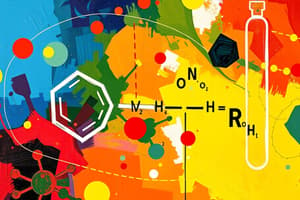Podcast
Questions and Answers
For every photon of light absorbed, thousands of ______ molecules are formed.
For every photon of light absorbed, thousands of ______ molecules are formed.
chloromethane
Inhibitors, such as ______, slow down the reaction.
Inhibitors, such as ______, slow down the reaction.
oxygen
The reaction of a carboxylic acid with an alcohol produces an ______.
The reaction of a carboxylic acid with an alcohol produces an ______.
ester
The process described for soap-making is referred to as ______.
The process described for soap-making is referred to as ______.
An addition reaction occurs when two or more molecules react to form a single ______.
An addition reaction occurs when two or more molecules react to form a single ______.
In the hydrogenation of vegetable oils, the geometry changes from ______ to tetrahedral bonds.
In the hydrogenation of vegetable oils, the geometry changes from ______ to tetrahedral bonds.
The Br2 molecule undergoes ______ fission to split into ions.
The Br2 molecule undergoes ______ fission to split into ions.
The ______ ion is formed when a Br~+~ attacks the C=C double bond.
The ______ ion is formed when a Br~+~ attacks the C=C double bond.
A substitution reaction is a chemical reaction in which an atom or a group of atoms in a molecule is replaced by another atom or group at atoms, often involving ______.
A substitution reaction is a chemical reaction in which an atom or a group of atoms in a molecule is replaced by another atom or group at atoms, often involving ______.
The overall reaction of the halogenation of alkanes requires the presence of ______ light.
The overall reaction of the halogenation of alkanes requires the presence of ______ light.
In the mechanism of monochlorination of methane, a chlorine atom attacks a methane molecule to form ______.
In the mechanism of monochlorination of methane, a chlorine atom attacks a methane molecule to form ______.
The mechanism described is known as a free-radical ______.
The mechanism described is known as a free-radical ______.
A product from one step of the reaction being a reactant for another step defines a ______ reaction.
A product from one step of the reaction being a reactant for another step defines a ______ reaction.
When most of the reactants have been used up during the reactions, methane radicals and chlorine radicals combine to form ______.
When most of the reactants have been used up during the reactions, methane radicals and chlorine radicals combine to form ______.
In the first step of initiation, a chlorine molecule is broken down into two chlorine atoms in the presence of ______.
In the first step of initiation, a chlorine molecule is broken down into two chlorine atoms in the presence of ______.
If excess chlorine is used in the halogenation of alkanes, further substitutions can lead to the formation of ______.
If excess chlorine is used in the halogenation of alkanes, further substitutions can lead to the formation of ______.
No red precipitate is observed. Ketones are not oxidised by ______.
No red precipitate is observed. Ketones are not oxidised by ______.
Using a graduated disposable pipette, place in a clean test-tube 3 cm^3^ of silver nitrate solution and 1 cm^3^ of ______ solution.
Using a graduated disposable pipette, place in a clean test-tube 3 cm^3^ of silver nitrate solution and 1 cm^3^ of ______ solution.
Add aqueous ammonia solution drop by drop, with shaking, until the precipitate formed in stage 1 is just ______.
Add aqueous ammonia solution drop by drop, with shaking, until the precipitate formed in stage 1 is just ______.
Rinse out the test-tube with dilute ______ acid and then water.
Rinse out the test-tube with dilute ______ acid and then water.
Fizzing is observed in the test tube, a mild pop is heard when testing with ______.
Fizzing is observed in the test tube, a mild pop is heard when testing with ______.
The lighted taper is extinguished and limewater turns a milky white colour when testing with ______.
The lighted taper is extinguished and limewater turns a milky white colour when testing with ______.
Ethene and chlorine react to form ______.
Ethene and chlorine react to form ______.
The first stage of Mass Spectrometry is ______, where the sample material is vaporised into a gas.
The first stage of Mass Spectrometry is ______, where the sample material is vaporised into a gas.
Particles that are too ______ are deflected too much and hit the side of the spectrometer.
Particles that are too ______ are deflected too much and hit the side of the spectrometer.
Only particles that have a certain ______ are deflected by just the right amount and make it through the spectrometer.
Only particles that have a certain ______ are deflected by just the right amount and make it through the spectrometer.
The height of each peak in the mass spectrum represents the relative ______ of particles of that mass.
The height of each peak in the mass spectrum represents the relative ______ of particles of that mass.
Chromatography is a separation technique in which a mobile phase carrying a mixture moves in contact with a selectively ______ stationary phase.
Chromatography is a separation technique in which a mobile phase carrying a mixture moves in contact with a selectively ______ stationary phase.
In paper chromatography, the stationary phase is ______ paper.
In paper chromatography, the stationary phase is ______ paper.
In column chromatography, the stationary phase is ______ gel in a glass tube.
In column chromatography, the stationary phase is ______ gel in a glass tube.
Passing a solvent through a column is known as ______.
Passing a solvent through a column is known as ______.
The Principle of Gas Chromatography is that a mixture of components is carried by a gaseous mobile phase is separated based on their different ______ with a solid stationary phase.
The Principle of Gas Chromatography is that a mixture of components is carried by a gaseous mobile phase is separated based on their different ______ with a solid stationary phase.
Gas Chromatography uses an inert ______ gas as the mobile phase.
Gas Chromatography uses an inert ______ gas as the mobile phase.
The stationary phase in Gas Chromatography is a coiled column filled with coated ______ gel.
The stationary phase in Gas Chromatography is a coiled column filled with coated ______ gel.
High Performance Liquid Chromatography (HPLC) utilizes a suitable liquid solvent under high ______.
High Performance Liquid Chromatography (HPLC) utilizes a suitable liquid solvent under high ______.
Infra-red spectroscopy helps identify organic compounds by analyzing their absorption of ______ radiation.
Infra-red spectroscopy helps identify organic compounds by analyzing their absorption of ______ radiation.
Ultraviolet spectroscopy results in a fingerprint for each compound and can also measure its ______.
Ultraviolet spectroscopy results in a fingerprint for each compound and can also measure its ______.
In chromatography, a pencil line is made to mark the starting point for ______ placement.
In chromatography, a pencil line is made to mark the starting point for ______ placement.
Stationary phase for High Performance Liquid Chromatography is also a coated ______ gel.
Stationary phase for High Performance Liquid Chromatography is also a coated ______ gel.
The first step in paper chromatography involves adding ______ to the bottom of the tank.
The first step in paper chromatography involves adding ______ to the bottom of the tank.
To confirm that a colourless liquid sample was ethanoic acid, a student could add ______ potassium permanganate.
To confirm that a colourless liquid sample was ethanoic acid, a student could add ______ potassium permanganate.
A sample of ethene gas can be shown to be unsaturated by adding a ______ solution, which changes from brown to colourless.
A sample of ethene gas can be shown to be unsaturated by adding a ______ solution, which changes from brown to colourless.
In paper chromatography, a mixture is applied using a dropper spot on paper slightly above the ______ in the beaker.
In paper chromatography, a mixture is applied using a dropper spot on paper slightly above the ______ in the beaker.
For recrystallizing impure benzoic acid, the suitable solvent is ______.
For recrystallizing impure benzoic acid, the suitable solvent is ______.
One flaw in the steam distillation apparatus assembly was that the end of the safety tube was ______ water.
One flaw in the steam distillation apparatus assembly was that the end of the safety tube was ______ water.
Flashcards
Substitution Reaction
Substitution Reaction
A chemical reaction where an atom or group of atoms are replaced by another.
Halogenation of Alkanes
Halogenation of Alkanes
Alkanes reacting with halogens (like chlorine) to form haloalkanes, which are alkanes with some hydrogens replaced by halogens.
Mechanism
Mechanism
Step-by-step, detailed explanation of a chemical reaction.
Free-radical substitution
Free-radical substitution
Signup and view all the flashcards
Chain reaction
Chain reaction
Signup and view all the flashcards
Monohalogenation
Monohalogenation
Signup and view all the flashcards
UV light in substitution reactions
UV light in substitution reactions
Signup and view all the flashcards
Free Radical
Free Radical
Signup and view all the flashcards
Chain Reaction (Chloromethane)
Chain Reaction (Chloromethane)
Signup and view all the flashcards
Free Radicals and Reaction Rate
Free Radicals and Reaction Rate
Signup and view all the flashcards
Esterification Reaction
Esterification Reaction
Signup and view all the flashcards
Addition Reaction
Addition Reaction
Signup and view all the flashcards
Hydrogenation of Oils
Hydrogenation of Oils
Signup and view all the flashcards
Polarization (Br2 and Ethane)
Polarization (Br2 and Ethane)
Signup and view all the flashcards
Heterolytic Fission
Heterolytic Fission
Signup and view all the flashcards
Carbonium Ion Formation
Carbonium Ion Formation
Signup and view all the flashcards
Ketones and Fehling's solution
Ketones and Fehling's solution
Signup and view all the flashcards
Magnesium and oxidation
Magnesium and oxidation
Signup and view all the flashcards
Sodium carbonate and litmus test
Sodium carbonate and litmus test
Signup and view all the flashcards
Mass spectrometry principle
Mass spectrometry principle
Signup and view all the flashcards
Mass spectrometry vaporization
Mass spectrometry vaporization
Signup and view all the flashcards
Mass spectrometry ionization
Mass spectrometry ionization
Signup and view all the flashcards
Mass spectrometry acceleration
Mass spectrometry acceleration
Signup and view all the flashcards
Mass spectrometry separation
Mass spectrometry separation
Signup and view all the flashcards
Mass Spectrometry
Mass Spectrometry
Signup and view all the flashcards
Mass Spectrum
Mass Spectrum
Signup and view all the flashcards
Peak Height in Mass Spectrum
Peak Height in Mass Spectrum
Signup and view all the flashcards
Chromatography
Chromatography
Signup and view all the flashcards
Stationary Phase (Chromatography)
Stationary Phase (Chromatography)
Signup and view all the flashcards
Mobile Phase (Chromatography)
Mobile Phase (Chromatography)
Signup and view all the flashcards
Paper Chromatography
Paper Chromatography
Signup and view all the flashcards
Elution
Elution
Signup and view all the flashcards
Ethanoic acid vs ethanol test
Ethanoic acid vs ethanol test
Signup and view all the flashcards
Unsaturated hydrocarbon test
Unsaturated hydrocarbon test
Signup and view all the flashcards
Melting point and purity
Melting point and purity
Signup and view all the flashcards
Recrystallization solvent
Recrystallization solvent
Signup and view all the flashcards
Gas Chromatography (GC)
Gas Chromatography (GC)
Signup and view all the flashcards
Mass Spectrometry (MS)
Mass Spectrometry (MS)
Signup and view all the flashcards
Infrared Spectroscopy (IR)
Infrared Spectroscopy (IR)
Signup and view all the flashcards
Ultraviolet Spectroscopy (UV)
Ultraviolet Spectroscopy (UV)
Signup and view all the flashcards
Stationary Phase
Stationary Phase
Signup and view all the flashcards
Mobile Phase
Mobile Phase
Signup and view all the flashcards
Study Notes
Substitution Reactions
- A substitution reaction is a chemical reaction where an atom or group of atoms in a molecule is replaced by another atom or group.
- Alkanes undergo substitutions in their reactions with halogens in the presence of ultraviolet light.
- Example: CH4 + Cl2 → CH3Cl + HCl (methane + chlorine → chloromethane + hydrogen chloride)
- The mechanism of a reaction is a detailed step-by-step description of how the overall reaction occurs.
- Halogenation of alkanes is a type of substitution reaction.
- Further substitution can result in dichloromethane (CH2Cl2), trichloromethane (CHCl3), and tetrachloromethane (CCl4).
Mechanism of Monochlorination of Methane
- The mechanism is known as free-radical substitution.
- Initiation: A chlorine molecule breaks down into two chlorine atoms in the presence of ultraviolet light.
- Propagation: A chlorine atom attacks a methane molecule to form hydrogen chloride and a methyl free radical.
- Propagation: A methyl free radical attacks a chlorine molecule to form chloromethane and a chlorine atom.
- Termination: When most reactants are used, chlorine and methyl radicals left combine to form Cl2, chloromethane, and ethane.
Evidence for Substitution Mechanisms
- Reaction takes place when exposed to UV light.
- For every photon of light absorbed, thousands of chloromethane molecules are formed.
- Ethane is a product of the reaction.
- Free radicals speed up the reaction.
- Inhibitors such as oxygen slow down the reaction.
Addition Reactions
- An addition reaction is one in which two or more molecules react together to form a single molecule.
- Always occurs on a double or triple bond.
- Geometry changes from planar to tetrahedral.
- Used in the hydrogenation of vegetable oils and formation of plastics.
- Polarisation: The C=C double bond in ethene has a high concentration of electrons. As Br2 approaches ethene, the electrons repel, polarising the Br2.
- Heterolytic Fission: The Br2 molecule splits into Br⁺ and Br⁻ ions. Carbonium ion formation: The Br⁺ attacks the electron-rich C=C double bond forming a carbonium ion. Ionic addition: The carbonium ion is then attacked by a Br⁻ ion, forming 1,2-dibromoethane.
Polymerisation Reactions
- Polymers are long-chain molecules formed by joining many small molecules (monomers) together.
- Polymers are repeating structures of linked monomers e.g. (Poly)chloroethane, PVC.
- Definition: The repeating unit of a polymer is the part of the polymer whose repetition produces the complete polymer chain, excluding the end groups. Polyvinyl chloride is synthesised from ethene.
Elimination Reactions
- An elimination reaction is one where a small molecule is removed from a larger molecule to leave a double bond in the larger molecule.
Redox Reactions
- When a primary alcohol reacts with an oxidizing agent, the primary alcohol converts to an aldehyde by removing two hydrogen atoms. Example: Primary alcohol → Aldehyde → Carboxylic acid
- If a secondary alcohol reacts with acidified sodium dichromate, a ketone is formed. Example: Secondary alcohol → Ketone
Mandatory Experiment: To prepare a sample of Soap
- Detailed procedures are given for the preparation of soap, including the use of lard, potassium hydroxide, and ethanol in a reflux apparatus.
Studying That Suits You
Use AI to generate personalized quizzes and flashcards to suit your learning preferences.




